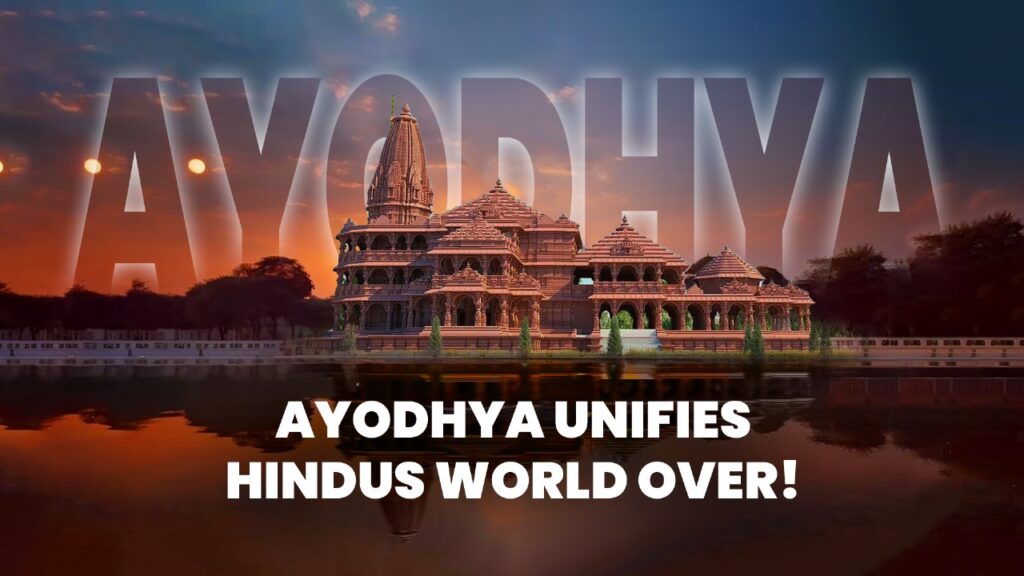
Ayodhya Unifies Hindus World Over!
For hoi polloi, Bhagwan Ram embodies an ideal leader to emulate. Ram mandir attracts people from diverse linguistic and cultural backgrounds
Ayodhya, an ancient city in Uttar Pradesh, Bharat, has been in focus of religious and political discourse due to Babri structure constructed by Mughal invader Babar over the site of Ram Janmabhoomi, birthplace of Bhagwan Ram, a revered Hindu deity.

After years of legal battles and societal tensions, the landmark verdict by Supreme Court of India finally handed over the Ram Janmabhoomi to Hindus and allotted separate land to Muslims, paving the way for the construction of a grand Ram Mandir (temple).
This monumental decision has not only brought a sense of closure to a longstanding issue but served as a unifying force for Hindus across the globe. The construction of Ram Mandir has arisen as an illustration of unity among Hindus, transcending regional and cultural boundaries.
Devotees from all corners of Bharat as well as globe representing diverse linguistic and cultural backgrounds have come together to contribute to construction of the grand temple viewing it as a sacred endeavour that reaffirms their faith and heritage.
Ram Mandir is one of the most sacred places in Bharat. Every day, 200,000 devotees have begun to flock Ayodhya to worship Bhagwan Ram Lalla following ‘pran pratishta’ on January 22 this year. From southern sun-soaked states, this holy place strengthens the already strong bond among people of the Bharat in a spiritual harmony.
This huge number of devotees also marks a big change in Ayodhya’s growth and devotees thank the government efforts for turning Ram Mandir into a reality.
One remarkable aspect of Ram Mandir is that it united Hindus from diverse backgrounds. Devotees from every corner of Bharat, regardless of linguistic, regional or cultural backgrounds have contributed to construction of the temple underscoring the universal appeal of Bhagwan Ram. This unity in diversity is exemplified by the participation of devotees of North to South who have come together in the spirit of shared devotion and purpose.
Devotees like Sridhar from Tamil Nadu and Revanthi from Telangana who visited Ayodhya for darshan of Ram Lala, highlight that “the temple transcends regional boundaries. This dispels the myth of a north-south divide and emphasizes the shared cultural heritage of Bharat.”
Every Ram devotee regardless of language or geography of south and north actively participated in campaigns such as fundraising, volunteer work and religious ceremonies associated with construction of the Bhagwan Ram temple. This cross-regional association highlights the supreme power of faith and emphasizes the significance of the Ram Mandir as a unifying symbol for Hindus globally.
A Maharashtrian family believes the temple transcends state boundaries and uplifts the entire nation. They express a desire for the restoration of temples in Kashi and Mathura destroyed in the past, hoping for their revival under the current leadership.
As per Maharishi Valmiki’s Ramayana, Ram is an institution of faith, hope, unity, justice, harmony, discipline, family, etc. and the Ram mandir is a medium to teach those irreplaceable values.
Beyond the borders, the construction of the Ram Mandir has garnered immense support and participation from the Hindus globally. A Hindu non-resident Indian family from USA expressed their joy and gratitude for witnessing the reinstallation of Ram Lulla’s idol.
A family from Jharkhand with roots in Mithila sees the temple as a source of national pride uniting Hindus worldwide. Hindu diaspora in countries such as United States of America, Canada, United Kingdom, and Australia have contributed financially and emotionally in the Ram Mandir construction and Pran Pratishtha believing it as a historic moment that reaffirms their cultural identity and religious heritage.
Ram Mandir stands not only as a physical structure but demonstrates lasting faith and collective aspirations of Hindus across the globe. The Bhartiya system which teaches values and principle of “Vasudhaiva Kutumbkam” envisions whole world as a big family and “Sarve bhavantu sukhinah, Sarve santu niramayah, Sarve bhadrani pasyantu, Ma kaschit duhkhabhag bhavet” translated as “May all beings be happy, may all be free from disease, may all see auspiciousness, may none be afflicted with suffering.”
These shlokas convey that human aspirations for prosperity and happiness are universal and there is a common goal that transcends culture and location. At its core, the Ram Mandir is not only a sign of faith but a symbol of hope for communal harmony and shared prosperity.
The construction of Ram Mandir in Ayodhya marks a milestone in Bharat’s cultural and religious history. Apart from its grandeur, the temple also symbolizes the collective determination and commitment of Hindus from all over the globe.
By bridging the regional divides and creating a sense of harmony among different communities, the Ram mandir symbolizes the eternal legacy of Bhagwan Ram and timeless values that he stands for. Estimated seven million devotees have reportedly had darshan of Ram Lulla in first few weeks it self.
(Author Vivek Raina is Manager Outreach & Dissemination at Centre for Integrated and Holistic Studies)

